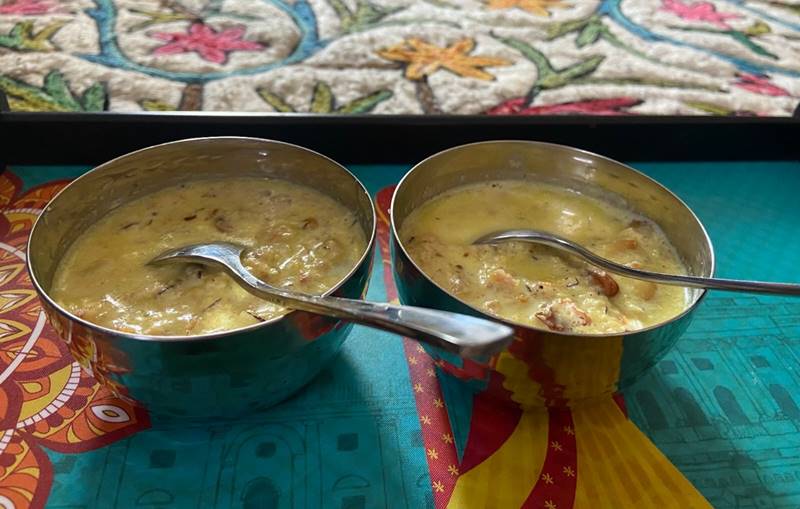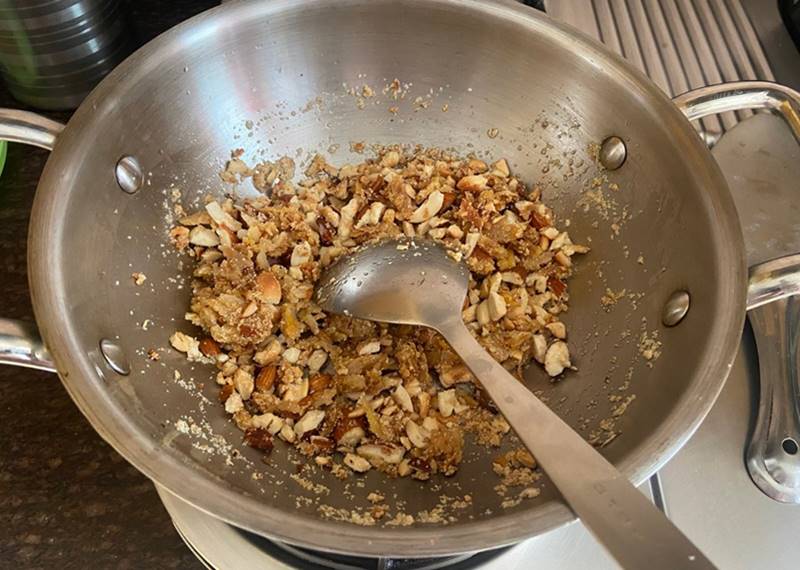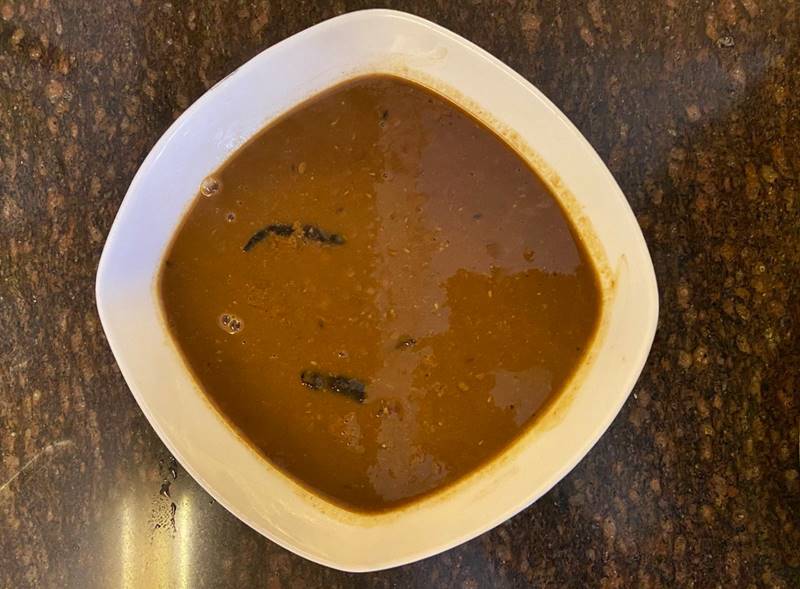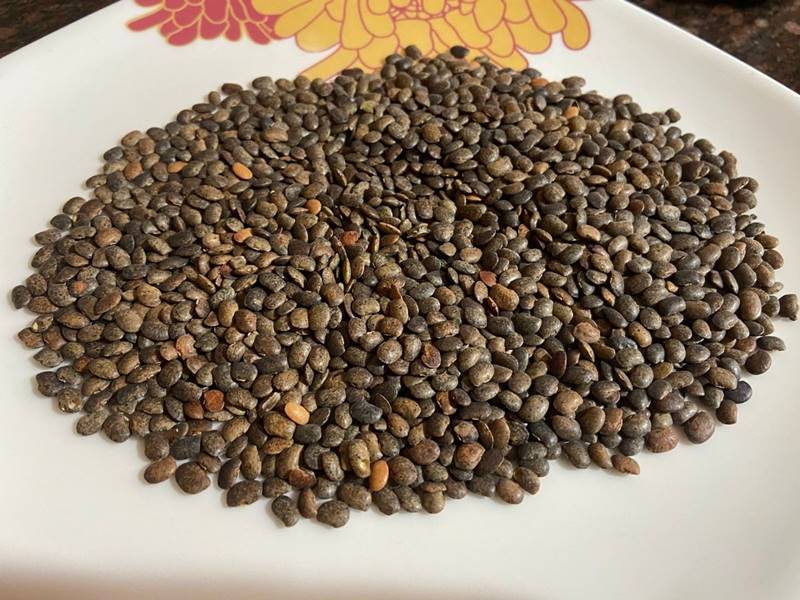It’s chillai kalan in J&K and here are some traditional Dogra recipes to keep you warm
There is a rich heritage of Dogra recipes and traditional flavours from the royal kitchens of Dogra rulers of the Jammu region. ‘Meetha Saluna’ or ‘Meetha Madra’, a sweet dish cooked with dry fruits and milk, is one such dessert. It helps beat the cold season. And, there is a recipe of desi kulth dal too, which again helps keep the body warm.


Meetha Saluna is cooked during festivals and I recently prepared it for Lohri, our harvest festival.
Chillai Kalan, or the 40-day extreme cold period in the winter season, is currently underway in the Kashmir region of Jammu & Kashmir (J&K) with freezing temperatures. This harshest spell of winter, which starts from December 21, will end on January 30. The Jammu region of the union territory also experiences extreme cold waves and the local Dogra population of the region has traditional recipes to suit the harsh climate.
Mostly, when we talk of J&K cuisine, Kashmiri cuisine of dum alu, rogan josh, yakhni and wazwan comes to mind. However, there is a rich heritage of Dogra recipes and traditional flavours from the royal kitchens of Dogra rulers that have failed to reach the kitchens of restaurants and hotels in cities across the country. These recipes are in keeping with the local climate and the highly nutritious agri produce of the region. There are food items which are to be consumed only in summers and then there is a long list of food items that should be consumed in winters.
J&K winters can be cruel and unforgiving. January month in north India witnesses nail biting cold weather, so a traditional Dogra “Heaty Sweetdish” is apt for the season. ‘Meetha Saluna’ or ‘Meetha Madra’ is a sweet dish, which is a combination of dry fruits and milk. No, it is not kheer or phirni.

Also Read: The Nakima Chronicles: A Sikkim treat that charms gourmands
Meetha Saluna is cooked during festivals and I recently prepared it for Lohri, our harvest festival.
It is definitely prepared on Diwali, which rightly coincides with the beginning of the winter season.
Meetha Saluna can be eaten as a sweet dish all alone or consumed as a side dish with “babru”, which is wheat dough fermented naturally and fried (like puris). Dry fruits are roasted in ghee and then boiled with milk and sugar. Because of its “heaty nature”, this sweet dish can give instant relief from cold in the harsh winters of J&K.
Recipe: Meetha Saluna or Meetha Madra
Ingredients
Almonds (Coarsely ground) – 10 to 12
Cashew nuts (Coarsely ground) – 10 to 12
Dry dates (Soaked overnight and coarsely crushed) – 6 to 7
Dry coconut (Grated) – 1/4th
Raisins/kishmish – handful
Sooji (semolina) – 1/2 tsp
Haldi – a pinch
Ghee – 2 tbsp or little more
Milk – more than half a litre
Sugar – to taste
Method
Coarsely crush almonds, cashews and dry dates (chhuaara in local language) in mortar and pestle (each one separately). Grate dry coconut and keep aside.
In a kadhai (wok) or heavy bottom pan, pour ghee and roast raisins till they swell up. Pay attention not to burn them. Take them out. In the same ghee, add sooji and slightly roast it. Add almonds and cashews and slightly roast them before adding dry coconut.

Stir the mixture for a minute or two and then add crushed dry dates. Mix everything well. Add a pinch of haldi powder for that beautiful earthy golden colour (not everyone could afford expensive strands of saffron so haldi was and still remains a good substitute). Add milk to this ghee laced dry fruit mix.
Remember to keep the flame at medium heat and let the milk come to a boil. Once it starts to boil, add raisins and saffron strands. The idea behind adding raisins afterwards is that sometimes raisins can curdle the milk if added earlier. Simmer the mix for some good 20-30 minutes stirring in between occasionally.
Add sugar once you reach the desired consistency before switching off the gas. Remember to use little sugar first and taste it as raisins too release their natural sugar in the milk. I like my Madra a little thick, you can either have it in a runny form from a glass and munch on the softened nuts in between, or can have it in the kheer consistency, the way I like.

The dish – Meetha Madra – indeed belonged to the Royal Kitchens of Dogra Rulers yet percolated down to the kitchens of the commoners of Jammu region.
A large part of the country is at present experiencing a severe cold wave. So grab a handful of dry fruits and prepare the delicious Meetha Madra.
Also Read: Full of Beans: Wholesome winter food in Uttarakhand
Pahadi kulth dal
Kulth or horse gram is the most protein rich lentil found in our planet, say nutritionists. It is packed with power and hence used as feed for horses before races, possibly that’s why it is called horse gram.
Kulth dal has remained a part of Jammu region’s winter foods for ages. While people in other parts of the country consume this lentil throughout the year, we in J&K make sure to bring this ‘power packed lentil’ in our kitchens only during the winter season and discontinue its use once it starts to get warm.

Our grandmothers and mothers always warned us of its ‘heat generating nature’ and instructed us not to cook it in the summers.
Apart from its benefits as a ‘high protein lentil’, some other wellness incentives of bringing kulth in our diets range from treating issues such as asthma, urinary problems, jaundice and even menstrual problems. It also helps in controlling diabetes, treating kidney stones and protects the liver. That’s why now this humble staple dal of J&K region is being branded as a ‘superfood’.
Also Read: Chhath Puja: From thekua to ole curry, here are six easy food recipes
Unlike kulth found in southern or western India, kulth or “desi kulth” as we in J&K call it, is bigger in size, can’t be stored for more than one or two months and its colour starts to change with time. The dark colour is the warning signal that the lentil is no longer good to use.
In Dogra households of the Jammu region, it is either consumed as a dal along with rice, or is used in making the delicious “kulth ki khichadi“.
Recipe: Kulth dal
Ingredients
Desi kulth – 1 cup
Tamarind pulp – 1tbsp soaked in one-and-a half-cups of water
Dry red chilli – 2
Jeera (cumin seeds) – half tsp
Red chilli powder – 1 tsp or as per your taste
Coriander powder – 1.5 tsp
Turmeric powder – half tsp
Ghee – For tadka
Method
Take the lentil and clean and pick it thoroughly. Once thoroughly cleaned, ensure to wash it for some four to five times in running tap water before soaking it in fresh water overnight.
Next morning, in a pressure cooker, boil water, add turmeric powder, salt, pinch of hing followed by the soaked kulth dal. Pressure cook it for 4-5 whistles (cooking time varies from region to region) till it’s cooked. Meanwhile, soak tamarind for sometime. Boil the pulp and mash it properly before discarding the seeds. Keep the tamarind water for later use.
In a heavy bottom pan (parthi pateela as is called locally) or kadhai, add 2-3 tbsp of ghee. Add dry red chillies, jeera and hing and let those splutter. Keep the flame low and add red chilli powder immediately followed by little water. This will ensure you get bright coloured gravy afterwards. Add coriander powder and then add the boiled dal without water. Keep the water in which dal was boiled as we are going to use it later on. The gravy becomes homogeneous if dal is cooked like this.

Keep mashing the dal with a ladle while mixing it with other masalas. Once ghee starts to appear on the sides, add tamarind water and let it boil for 5-7 minutes. Add little salt if necessary. Now add water in which dal was boiled. Let the whole thing come to a boil and then simmer it. Keep the lid on the top but don’t cover it fully.
Let kulth boil for another 10 minutes on medium low heat. I always cover the lid and bring the dal to a boil in the end for two minutes. Our humble “superfood” dal is ready. Always serve it piping hot on the bed of hot steamed rice. And remember, this dal’s consistency is never kept thick.
So how about enjoying some Dogra cuisine this weekend? Kulti-rice followed by Meetha Madra?

